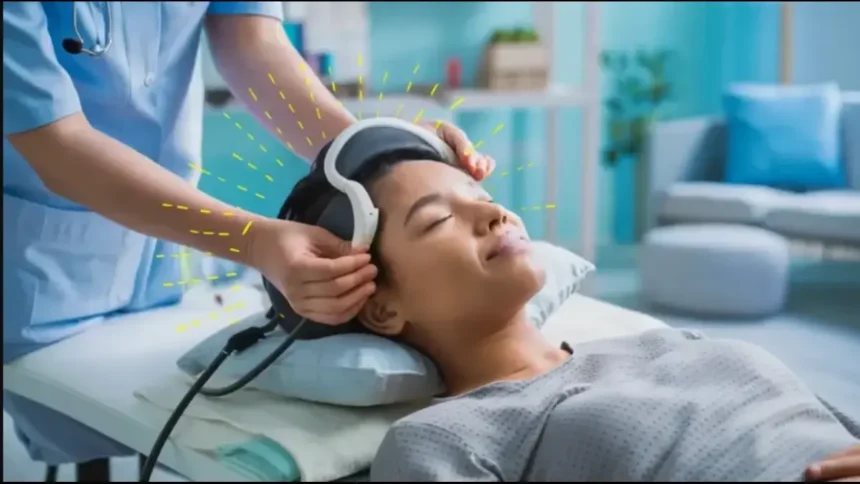Are you seeking relief from depression, anxiety, or other debilitating mental health conditions? If so, Transcranial Magnetic Stimulation (TMS) treatment might be on your radar. Specifically, TMS treatment administered by Advanced Practice Nurses (APN) has gained traction as an innovative approach to therapy. With its non-invasive nature and growing body of research supporting its effectiveness, more patients are exploring this option.
In a world where mental health awareness is increasing and stigma is decreasing, it’s essential to understand the ins and outs of TMS treatment APN. From who can benefit to practical tips for maximizing results, we’re diving deep into everything you need to know about this revolutionary therapy method. Whether you’re considering it for yourself or someone close to you, knowledge is power in making informed decisions about mental well-being. Let’s embark on this informative journey together!
A Step-by-Step Guide to tms treatment apn
Getting started with TMS treatment APN involves several key steps that ensure a smooth experience.
First, you’ll undergo an initial evaluation. This typically includes a comprehensive assessment of your mental health history and current symptoms. The goal is to determine if TMS is the right fit for you.
Once approved, the next step is scheduling sessions. Treatments generally occur five days a week over several weeks. Each session lasts about 20 to 40 minutes, making it easier to incorporate into your daily routine.
During each visit, you’ll be comfortably seated in a specialized chair. A magnetic coil will be placed on your head, delivering targeted pulses that stimulate brain activity associated with mood regulation.
Afterward, patients can return to their normal activities immediately. Many people report minimal side effects such as mild headaches or scalp discomfort but find the benefits far outweigh any drawbacks during this healing journey.
Who Can Benefit from tms treatment apn?
TMS treatment APN can be a game-changer for those struggling with depression, especially when traditional therapies have fallen short. Individuals who experience chronic anxiety or mood disorders may also find relief through this innovative approach.
Moreover, patients dealing with obsessive-compulsive disorder (OCD) and post-traumatic stress disorder (PTSD) are increasingly exploring TMS as an option. Its non-invasive nature makes it appealing to many seeking alternatives to medication.
Even healthcare providers notice potential benefits for their patients who resist pharmacological treatments due to side effects or personal preferences.
This therapy offers hope not just for individuals but also families affected by mental health issues. By providing an alternative, TMS treatment APN paves the way towards better emotional well-being and improved quality of life for various demographic groups across age ranges and backgrounds.
10 Tips for Achieving tms treatment apn
Achieving the best results from TMS treatment APN requires a proactive approach. Start by attending all scheduled sessions without fail. Consistency is key to maximizing effectiveness.
Engage openly with your healthcare provider. Share any concerns or experiences during the process, as this feedback can tailor your care plan more effectively.
Maintain a healthy lifestyle outside of therapy. Balanced nutrition and regular exercise can support mental health and enhance treatment outcomes.
Establish a supportive network around you. Family and friends can provide encouragement that makes a significant difference in your journey.
Stay informed about TMS techniques and advancements through reputable sources. Knowledge empowers you to actively participate in your treatment decisions.
Consider mindfulness practices such as meditation or yoga; these may help reduce anxiety throughout the process.
Track your progress carefully, noting changes in mood or daily functioning for discussions with your provider.
Be patient with yourself—TMS takes time for full effects to manifest, so embrace each step along the way.
Is tms treatment apn Right for You?
Determining if TMS treatment APN is right for you involves careful consideration of your mental health needs. This therapy often targets conditions like depression and anxiety, particularly when traditional methods haven’t provided relief.
Consulting with a healthcare professional is essential. They can assess your history and current state to see if this non-invasive approach suits you.
Consider your lifestyle too. TMS requires multiple sessions over several weeks, so think about how that aligns with your schedule and commitments.
Additionally, reflect on past treatments. If medications or psychotherapy haven’t worked for you, TMS might offer the breakthrough you’ve been searching for.
Be open about any concerns regarding side effects or the procedure itself. Knowledge empowers decision-making in finding what best supports your mental wellness journey.
Top 10 Facts About tms treatment apn
TMS treatment APN, or Transcranial Magnetic Stimulation Treatment Advanced Practice Nursing, has gained significant attention in mental health care.
This non-invasive procedure uses magnetic fields to stimulate nerve cells in the brain. It primarily aims to treat depression and anxiety disorders.
One interesting fact is that TMS does not require anesthesia. Patients remain awake during sessions, allowing them to return to their daily activities immediately afterward.
Research indicates that about 50-60% of patients experience a significant reduction in symptoms after a full course of treatment. This makes it a viable option for those who have not responded well to traditional therapies.
Additionally, TMS treatments are typically well-tolerated with minimal side effects, mainly minor headaches or scalp discomfort.
Sessions usually last around 20-40 minutes and are conducted over several weeks for optimal results.
Another point worth noting is that insurance coverage for TMS therapy has been increasing as its effectiveness becomes more recognized.
The Impact of tms treatment apn on Patient Care
TMS treatment APN significantly enhances patient care by providing a non-invasive option for those struggling with mental health issues. Patients often find it more accessible and less intimidating than traditional therapies.
This method targets specific brain regions associated with mood regulation, offering personalized solutions tailored to individual needs. The precision of TMS helps minimize side effects compared to pharmaceuticals, improving overall quality of life.
Moreover, the collaborative approach between advanced practice nurses and patients fosters trust and communication. This relationship is vital in encouraging adherence to treatment plans.
Patients frequently report increased motivation and engagement during the process. Many witness marked improvements in their symptoms, allowing them to return to daily activities they once enjoyed.
The integration of TMS into clinical settings also highlights an evolving landscape in mental health care. It underscores the importance of innovative treatments that prioritize patient well-being above all else.
Conclusion
TMS treatment APN offers a promising avenue for individuals seeking relief from mental health conditions. With its non-invasive approach and growing body of research supporting its effectiveness, many are finding hope in this form of therapy. It’s essential to evaluate if this treatment aligns with your unique circumstances, as each person’s journey is different.
The step-by-step guide provided can help demystify the process while empowering patients to take charge of their care. Understanding who benefits from TMS treatment is crucial for making informed decisions about pursuing it. By implementing our tips, you can maximize your chances of successful outcomes and ensure a smoother experience throughout the process.
As awareness grows around TMS treatment APN, so does its potential impact on patient care overall. Education remains vital—knowing what to expect can alleviate anxiety associated with starting any new therapy.
If you’re considering TMS treatment APN, weigh all factors carefully and consult with healthcare professionals who understand your specific needs. Each story is unique; yours could lead to significant change and improvement in quality of life through this innovative therapy option.




